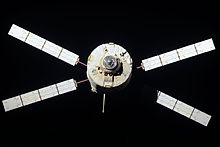Automated Transfer Vehicle
| Automated Transfer Vehicle | |
|---|---|
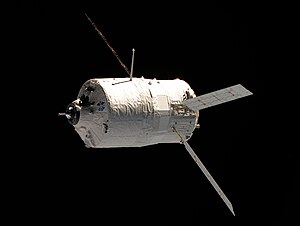
|
|
| Type: | Spaceship |
| Manufacturer: | |
| First flight: |
March 9, 2008 |
| Number of pieces: |
5 |
The Automated Transfer Vehicle ( ATV ; English for automatic transfer vehicle ) was an unmanned, non-reusable space tug , the replenishment such as food, water, equipment, nitrogen , oxygen and fuel to the International Space Station transported (ISS). After docking, it was also needed for evasive maneuvers by the space station in front of any approaching debris and for raising the orbit, the so-called "reboost", of the ISS. For this purpose, the ATV was equipped with its own re-ignitable drive. The ATV was built on behalf of the European Space Agency (ESA) by the space company EADS Astrium Space Transportation in Bremen and launched with the help of an Ariane 5 ES ATV rocket . After the first start in March 2008, four more flights took place until the end of the program in February 2015.
Use and technology
Basic flight history
A European launch vehicle Ariane 5 ES ATV took off with the ATV as a payload from the European spaceport in Kourou .
The ATV was equipped with a sophisticated navigation system with which it could determine its flight path and automatically calculate the course for the rendezvous maneuver with the space station and carry out the necessary control maneuvers itself. Because the ATV was supposed to dock with the Russian Zvezda module, a Russian development was used for the coupling mechanism. It was not possible to “catch” the ATV by the Canadarm2 robot arm , as is the case with the Japanese HTV . The Russian part of the station does not have suitable connectors, the so-called Power and Data Grapple Fixtures (PDGF). These are only installed in the US part of the ISS. The ATV could therefore not use Canadarm2, which was also one of the most important reasons for the automatic docking maneuver.
The ATV maneuvers were monitored by the ATV Control Center (ATV-CC), which was set up in 2002 in the French Center national d'études spatiales in Toulouse . This is where the cooperation with the two control centers responsible for the ISS in Moscow and Houston was coordinated.
Docked on the ISS, the ATV formed an extension of the station. Spacemen could enter the 45 m³ interior. The ATV was able to transport 7.5 tons of payload to the ISS. The supplies were removed and the vehicle loaded with up to 6.3 tons of waste that had accumulated in the space station. The ATV was also often used for sleeping purposes by the ISS crew while it was docked, because it had no permanently switched on interior lighting and was also not connected to the air conditioning system, which meant that the noise level was much lower.
During the coupling period, the ATV engines were used to lift the station into a higher orbit (maximum 500 km). Such corrections are necessary at regular intervals, as the ISS loses between 50 and 150 meters of altitude every day due to the friction with the remaining atmosphere in the earth's orbit of around 410 kilometers. Controlled thrusts from the ATV's drives made up for this loss. Each ATV carried enough fuel to raise the station up to 30 kilometers.
The ATV could stay connected to the ISS for up to six months. After that, it was deliberately crashed. For this purpose, after the decoupling maneuver by braking with the engines, the perigee of the orbit was lowered so far that the ATV dipped deep into the earth's atmosphere during the next perigee passage and largely burned up in the upper layers of the atmosphere.
The ATV was supposed to relieve the Russian, also unmanned, supply spaceship Progress significantly after the American space shuttle fleet was decommissioned . It had about three times the transport capacity of the Russian spaceship.
The ATV had various systems for navigation. For example, Star Tracker was able to determine one's own position in the room. At a greater distance from the ISS, the ATV was able to navigate using GPS . During the approach, GPS in relative mode to the ISS, optical systems and laser interferometers were used. Accelerometers and gyroscopes were also available.
The attitude control system controlled 28 engine nozzles, each delivering 220 Newtons of thrust. Monomethylhydrazine was used as fuel and MON3 as oxidizer .
costs
Although the ATV was a “disposable product”, its use was not necessarily more expensive than the supply of the (reusable) space shuttle orbiter, since there safety aspects compared to the crew involved considerable increases in costs.
| Spaceship | progress | Space Shuttle with MPLM | ATV |
HTV HTV-X |
Dragon 1 Dragon 2 |
Cygnus | Tianzhou | Dream chaser |
|---|---|---|---|---|---|---|---|---|
| Starting capacity | 2.2-2.4 t | 9 t | 7.7 t | 6.0 t 5.8 t |
6.0 t | 2.0 t (2013) 3.5 t (2015) 3.75 t (2019) |
6.5 t | 5.5 t |
| Landing capacity | 150 kg (with VBK-Raduga ) | 9 t | - | 20 kg (from HTV-7) | 3.0 t | - | - | 1.75 t |
|
Special skills |
Reboost, fuel transfer |
Transport of ISPR, transport of external loads, station construction, reboost |
Reboost, fuel transfer |
Transportation of ISPR , transportation of external loads |
Transportation of ISPR, transportation of external loads |
Transport of ISPR | Fuel transfer | |
| carrier | Soyuz | STS | Ariane 5 |
H-2B H3 |
Falcon 9 | Antares / Atlas 5 | Long March 7 | Vulcan |
|
Start-up costs (rough information) |
$ 65 million | $ 450 million | $ 600 million | HTV: $ 300-320 million | $ 150/230 million
(Dragon 1/2) |
$ 260/220 million (Cygnus 2/3) | ||
| Manufacturer | RKK Energija | Alenia Spazio (MPLM) | Airbus Defense and Space | Mitsubishi Electric | SpaceX | Orbital Sciences | CAST | Sierra Nevada |
| Period of use | since 1978 | 2001-2011 | 2008-2015 | 2009–2020 from 2022 |
2012–2020 from 2020 |
since 2014 | since 2017 | from 2021 |
italic = planned
Missions
| No. | designation | Surname | Start ( UTC ) | Coupling ( UTC ) | Decoupling ( UTC ) | Deorbit Burn ( UTC ) | Re-entry ( UTC ) |
|---|---|---|---|---|---|---|---|
| 1 | ATV-1 | Jules Verne | March 9, 2008 4:03 am |
April 3, 2008 2:45 p.m. |
September 5, 2008 9:32 pm |
September 29, 2008 12:58 pm |
September 29, 2008 1:31 pm |
| 2 | ATV-2 | Johannes Kepler | February 16, 2011 9:50 pm |
February 24, 2011 3:59 pm |
June 20, 2011 2:46 pm |
June 21, 2011 8:05 pm |
June 21, 2011 8:49 PM |
| 3 | ATV-3 | Edoardo Amaldi | March 23, 2012 4:34 am |
March 28, 2012 10:31 PM |
September 28, 2012 9:44 pm |
3rd October 2012 |
October 3, 2012 1:30 am |
| 4th | ATV-4 | Albert Einstein | June 5, 2013 9:52 pm |
June 15, 2013 2:07 pm |
October 28, 2013 8:59 am |
November 2, 2013 |
November 2, 2013 12:05 pm |
| 5 | ATV-5 | Georges Lemaître | July 29, 2014 11:47 PM |
August 12, 2014 13:30 |
February 14, 2015 1:42 PM |
February 15, 2015 | February 15, 2015 6:04 p.m. |
ATV-1: Jules Verne
The first ATV was launched on March 9, 2008. It was named Jules Verne in memory of the French science fiction writer. After an in-depth review of all systems and several rendezvous maneuvers, the unmanned space freighter docked successfully at the International Space Station on April 3. The coupling was the first fully automated docking maneuver in space that was not carried out by a Russian spacecraft.
At the end of April 2008, “Jules Verne” was used for the first time to raise the orbit of the ISS. With a five-minute test run of the ATV engines on April 21, the mean runway height was increased by 1.7 km. Four days later, the freighter raised the station by a further 4.7 km by igniting two engines with a burn time of 740 seconds. The total thrust of 1000 Newtons accelerated the station with its mass of 280 tons by 2.65 m / s.
On June 18, the first automatic fuel transfer of around 280 kg UDMH and 530 kg nitrogen tetroxide from the ATV into the ISS fuel tanks took place.
During the third reboost maneuver of the ATV on June 20, the orbit of the ISS was raised by 7 km. With the thrust of two engines, which lasted 20 minutes, the 300 ton mass of the ISS was accelerated by 4.05 m / s using 400 kg of fuel. After the reboost on July 23, the station was accelerated at the last reboost by Jules Verne on August 13, 2008 by 3.3 m / s and thus raised within 16 min 35 s by 5.8 km to an average height of 356 km . On August 27, 2008, an evasive maneuver of the ISS took place for the first time since 2003, during which the ATV was used to slow down the station before it undocked on September 5.
The re-entry of “Jules Verne” took place on September 29, 2008 at an altitude of 120 kilometers and was observed and documented in the “ATV Re-entry observation campaign” by two observer aircraft and from on board the ISS (see also). At an altitude of 75 km the vehicle broke; about 12 minutes later, remains fell into the Pacific.
ATV-2: Johannes Kepler
In February 2009 the European space agency decided to name the second transporter after the German astronomer and mathematician Johannes Kepler . On the basis of the planetary observations of Tycho Brahe , Kepler derived the Kepler laws named after him . The start was initially planned for February 15. Due to a problem with the sensors in one of the oxygen tanks of the main engine, the automatic take-off sequence was canceled four minutes before take-off and postponed by 24 hours. The launch of the Ariane 5, the heaviest payload of over 20 tonnes to date, went according to plan. Docking with the ISS took place on February 24th. The freight with a total mass of 7060 kg included a. 4535 kg of fuel to lift the ISS and 860 kg to refuel the Zarya module. Also on board was the GeoFlow II experiment - a model for simulating the convection processes in the earth's mantle, which had to work under weightlessness so that the central electric force field of the experiment was not overlaid. More precise information about the processes involved in the reentry of the space transporter should be obtained with the Reentry Breakup Recorder (REBR), a data logger that should record data on the disintegration of the transporter during the last phase of the flight and then send this to earth via the Iridium satellite network . The data should help to better understand the processes involved in the breakup and thus improve safety when spacecraft re-enters.
On June 12, 2011, the orbit of the ISS was raised by the ATV-2 by 19 km to an average orbit height of 365 km. For this purpose, two of the four engines of the space freighter worked in two sections of 36 and 40 minutes. The flight path of the ISS was further raised to around 380 km on June 15 and 17.
After the freighter had been loaded with 1.3 tons of waste, it separated from the station on June 20 for re-entry. On June 21, the ATV finally burned up over the South Pacific. The Reentry Breakup Recorder, equipped with its own heat protection shield , was supposed to transmit its data from an altitude of 18 km, but this failed.
ATV-3: Edoardo Amaldi
On March 16, 2010, ESA announced that the third ATV would be named after the Italian physicist Edoardo Amaldi . The launch was scheduled for March 9, 2012, but was postponed to March 23. ATV-3 took off on March 23 at 04:34 UTC (1:34 local time) from the Kourou spaceport in French Guiana on board an Ariane 5 ES to the ISS and automatically docked on March 28 at the rear (axial) docking port of the Russian one Residential and service module " Zvezda ".
In the meantime, there appeared to be a need to prematurely undock the ATV from the station because the station could not provide the freighter with power. The "Russian Equipment Control System" (RECS) is responsible for the data and energy supply of coupled spaceships in the Russian part of the space station. The system's primary channel failed. The station crew was then instructed to immediately transfer the most important goods from the space freighter to the ISS. The flight controllers in the mission centers in Houston, Koroljow and Toulouse managed to activate the secondary channel of "RECS" on March 31, so that the further mission of ATV-3, including the "reboosts" of the station, was guaranteed.
The decoupling, originally planned for September 25, 2012, was delayed by several days due to communication problems between the space transporter and the Zvezda module of the ISS. The ATV-3 finally left the station on September 28, 2012 and prepared for re-entry. Since the "REBR" of the ATV-2 could not transmit any data, it was placed further away from the drive tanks during the ATV-3 mission to avoid possible damage if the transporter broke. The re-entry took place on October 3rd as planned and was successfully documented with the Reentry Breakup Recorder.
ATV-4: Albert Einstein
The ATV-4 was named Albert Einstein . The launch took place on June 5, 2013, and the docking maneuver at the ISS took place on June 15, after Progress 51 had cleared the docking port on the Zvezda module. With a takeoff mass of 20,190 kg, ATV-4 was the heaviest payload ever flown by an Ariane.
As one of the first activities, the water pump, a spare part for the thermal control system of the Columbus module and the heaviest single piece of cargo, was unloaded and brought into the Columbus module. As a result, the first reboost maneuver took place to increase the speed of the ISS by 1 m / s.
After decoupling from the ISS on October 28, 2013, the ATV-4 burned up over the South Pacific on November 2, as planned.
ATV-5: Georges Lemaître
The ATV-5 was named after the Belgian astrophysicist Georges Lemaître , the founder of the Big Bang theory , and was launched on July 29, 2014. With a total weight of more than 20.2 tons, Ariane 5 brought more payload into orbit than ever before. The ATV-5 successfully docked with the ISS on August 12. It was the last supply ship in this series. After that, ESA stopped building these vans. The ISS was undocked on February 14, 2015. The following day the last ATV burned up in the earth's atmosphere.
With the ATV-5, a work of art by artist Katie Paterson was brought to the ISS from a 4.5 billion year old meteorite that fell to Earth around 4000 years ago.
End of the program
The ATV missions were so-called "barter elements" of the ESA, with which - instead of simple money transfers - you paid for your own participation in the ISS. The need for cargo flights to the space station was eliminated by the American cargo capsules Dragon and Cygnus , so that the ATV could no longer serve as a barter element. Instead, NASA and ESA decided to carry out the first flight of the Orion capsule with a European service module based on ATV technology, with which the experience gained with ATV will enter the next chapter of astronautical space travel.
Technical specifications
- Max. Length: 10.27 m
- Max. Diameter: 4.48 m (with extended solar panels 22.28 m)
- Empty weight: 10,470 kg
- Takeoff weight: 19,400 kg
- ATV consumables: 2,613 kg
- Payload capacity: (max. 7,667 kg, typically 7,500 kg) can be composed variably
- a maximum of 5,500 kg of dry material such as food
- maximum 4,700 kg of fuel
- maximum 860 kg of fuel for the ISS ( UDMH and nitrogen tetroxide )
- maximum 840 kg drinking water
- maximum 100 kg air (oxygen and nitrogen)
- Maximum possible mass at take-off: 20,750 kg
- Waste absorption capacity: typically 6,300 kg
- Energy supply: four solar cell panels and eight rechargeable batteries, energy consumption 400 to 900 W.
Studies on the further development of the ATV
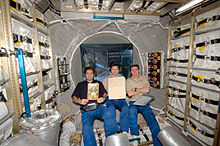
The concept study "ATV Evolution Scenarios" by ESA saw the ATV as the basis for the development of future spaceships. The reasons for this were, on the one hand, the expiry of the American space shuttle program, since until the planned Orion spaceship was introduced, only the Russian Soyuz spaceships would be available to transport astronauts to the ISS and, on the other hand, the support of the European space industry for the Ensure independence.
- UIC (Unpressurized Logistics Carrier)
- The UIC was supposed to bring several tons of non-pressurized cargo to the ISS. For this purpose, the freight module previously integrated in the ATV would have been replaced by the UIC. The cargo would then have been brought into its final position at the space station by the European Robotic Arm or an astronaut.
- LCRS (Large Cargo Return Spacecraft)
- The plan was to equip the ATV's cargo module with a heat shield for re-entry into the atmosphere. This would have made it possible to bring several hundred kilograms of cargo and experiments back to Earth. The concept of the Atmospheric Reentry Demonstrator (ARD), which was successfully tested in 1998, could have been used for this.
- CARV (Cargo Return Vehicle)
- The CARV was another, more detailed study with a higher budget from 2004. It should be able to dock on the American part of the ISS in order to exchange the International Standard Payload Racks (ISPR) and bring them back to Earth.
- Small payload return
- Taking advantage of the internal volume of the ATV, it should have been equipped with a small capsule for the return transport of around 150 kg of material to the earth.
- CTV (Crew Transport Vehicle)
- In the modification as a CTV, the ATV should enable the transport of astronauts. In the first phase, it should serve as a crew return vehicle (CRV) for the ISS. In a further development stage, it should be able to be used as a full-fledged spaceship to bring astronauts into space and back to Earth. In June 2006, ESA commissioned a study for a Crew Space Transportation System (CSTS). In it, the construction of a spaceship in cooperation with Russia was discussed, with which the moon orbit could be reached. Proven ATV technology should also be used.
- Free-Flying Lab / The Safe-Haven
- The ATV could have been developed into an unmanned free-flying laboratory comparatively easily. This should provide a better microgravity level for experiments. It was supposed to dock with the ISS to exchange experiments. Furthermore, such a module could have acted as a kind of lifeboat (safe haven). In the event of a serious incident on the ISS, this would have given enough time to rescue the crew with the help of a Soyuz spaceship.
- MSS (Mini Space Station)
- The ATV should be equipped with two docking mechanisms and thus serve to set up a mini space station or a space laboratory .
- ETV (Exploration Transport Vehicle)
- Further development of the ATV should be used for the transport of cargo and astronauts in the lunar and Mars orbit or for the use of space telescopes.
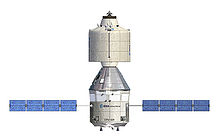
On May 14, 2008, EADS Astrium and DLR announced official plans to develop the ATV into a manned spacecraft. The spaceship was to be launched from a modified version of an Ariane 5 rocket and put three astronauts into low earth orbit . A mock-up of the planned spaceship was presented at the International Aerospace Exhibition 2008 in Berlin. The project should be implemented in two phases. The first phase envisaged the realization of an unmanned Cargo Return Vehicle (CARV) by 2015. The planned budget for the project would have been around one billion euros. The second phase envisaged the development of a spacecraft by 2020 that could have safely transported astronauts into orbit and back to Earth. The estimated costs were several billion euros.
On July 7, 2009, EADS Astrium received an order from ESA for a project study with a total volume of 21 million euros for the Advanced Re-entry Vehicle (ARV). Transportation of cargo to the ISS and back to Earth was studied as part of the ARV program. The first flight was planned for 2016 and the first flight of the manned version for 2022 at the earliest. Since the contract with NASA for the service module for the MPCV (see below), these plans are no longer pursued.
Further development to the service module of the MPCV / Orion
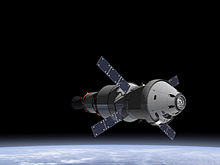
At the end of 2012, NASA and ESA reached an agreement to use an ATV-based service module for the first mission of the new NASA spacecraft (then Multi-Purpose Crew Vehicle (MPCV); later Orion ) on the SLS . With this contribution to the manned American space program, which goes beyond the low earth orbit, the ESA fulfills its obligations towards NASA, which arise from the use of the ISS and would have to be financially compensated after the end of the ISS freight transport with the ATV. NASA initially ordered two service modules. The first is to be used in 2021 for the Artemis 1 unmanned mission , which aims to achieve lunar orbit. The second mission, Artemis 2 , will then orbit the moon in a manned manner in 2022 , similar to Apollo 8 , but without entering orbit.
In November 2015, the first test module from Europe arrived in the USA with an Antonov An-124 . It was tested for space suitability at NASA's Glenn Research Center . At the beginning of November 2018, the service module for the first flight to the moon (EM-1) of the Orion spacecraft was flown from Bremen to the Kennedy Space Center / USA.
Web links
- Overview of the ATV on the DLR website
- Overview of the ATV on the ESA website (English)
- ESA: Jules Verne ATV Information Kit (English)
- ATV Jules Verne Launch Kit from Astrium (English; PDF file; 5.74 MB)
- ATV Johannes Kepler Launch Kit from Astrium (English)
- ATV Edoardo Amaldi Launch Kit from Astrium
- Video of the re-entry and burning up of the ATV "Jules Verne" (archived link) ( Memento from September 3, 2014 in the Internet Archive ) (MOV file; 24.6 MB)
- ESA: Johannes Kepler ATV Fact Sheet (PDF file; 4.7 MB), including 3D model (English)
- Raumzeit podcast on the ATV with the project manager Nico Dettmann
Individual evidence
- ↑ ATV - Current Status , June 17, 2008, accessed August 27, 2011
- ↑ Bernd Leitenberger: The ATV Jules Verne . 1st edition. Books on Demand GmbH, 2008, ISBN 978-3-8370-5572-6 , pp. 48 f .
- ↑ HTV-X on Gunter's Space Page, accessed on September 24, 2019.
- ↑ a b Dragon. SpaceX. In: spacex.com. Archived from the original on July 14, 2016 ; accessed on September 22, 2019 (English).
- ↑ a b Dragon. SpaceX. In: spacex.com. Retrieved September 22, 2019 .
- ^ Commercial Resupply Services. In: orbitalatk.com. Retrieved March 24, 2018 .
- ↑ Eric Berger: NASA to pay more for less cargo delivery to the space station. April 27, 2018, accessed September 22, 2019 .
- ^ Antares launches Cygnus cargo spacecraft on first CRS-2 mission . Spacenews, November 2, 2019.
- ^ A b Sierra Nevada firms up Atlas V Missions for Dream Chaser Spacecraft, gears up for Flight Testing. In: Spaceflight 101 July 9, 2017, accessed September 22, 2019 .
- ↑ Bernd Leitenberger: Progress. In: bernd-leitenberger.de. Retrieved March 24, 2018 .
- ↑ How much does it cost to launch a Space Shuttle? NASA, March 23, 2019, accessed March 23, 2019 .
- ↑ Stephen Clark: Fourth ATV attached to Ariane 5 launcher. In: spaceflightnow.com. Retrieved March 24, 2018 .
- ↑ Stephen Clark: Space station partners assess logistics needs beyond 2015. In: spaceflightnow.com. December 1, 2009, accessed March 24, 2018 .
- ↑ Robert Wyre: JAXA Wants ¥¥¥¥¥ for 2020 Rocket. In: majiroxnews.com. January 19, 2011, archived from the original on March 2, 2016 ; accessed on March 24, 2018 (English).
- ↑ a b SpaceX price hikes will make ISS cargo missions more costly . Engadget, April 27, 2018.
- ↑ Stephen Clark: Japan's HTV ready for launch with last set of new space station solar batteries . Spaceflight Now, May 19, 2020.
- ↑ a b Europe’s smart supply ship on its way to Space Station. ESA, March 23, 2012, accessed March 23, 2012 .
- ^ Europe's smart supply ship on its way to Space Station. ESA, March 29, 2012, accessed April 10, 2012 .
- ↑ a b Worldwide Launch Schedule. Spaceflight Now, July 23, 2014, accessed July 27, 2014 .
- ↑ ESA News: Europe launches its first ATV supply transporter "Jules Verne" to the ISS , March 9, 2008
- ↑ ATV lifts the International Space Station ISS. EADS Astrium, April 25, 2008, archived from the original on September 17, 2008 ; accessed on January 6, 2019 .
- ↑ ESA: Jules Verne boosts ISS orbit , April 25, 2008
- ↑ ESA: Premiere for Europe: Jules Verne refuels the ISS , June 21, 2008
- ↑ ESA ATV carries out first debris avoidance maneuver for the ISS 28 August, 2008.
- ↑ ESA: "Jules Verne" ATV Re-entry (PDF file; 2.9 MB), Sep 2008
- ^ ESA: Successful re-entry marks bright future for ATV
- ↑ Second ATV named after Johannes Kepler (English) - Article at ESA , February 19, 2009
- ↑ International partners update launch manifest. Arianespace, October 1, 2010, accessed October 1, 2010 .
- ↑ Operations timeline February 15/16, 2011 (English) - Article on the ATV blog , February 14, 2011
- ↑ Raumfahrer.net: ATV 2: Kepler is on the way to the ISS
- ↑ GeoFlow II: ISS experiments: convection currents of the earth's mantle in weightlessness
- ↑ ESA: ATV Johannes Kepler - Information Kit
- ^ Ian Benecken, Simon Plasger, Klaus Donath: Biggest orbital elevation of the ISS by ATV-2. Raumfahrer.net, June 13, 2011, accessed June 13, 2011 .
- ^ Thomas Weyrauch: ATV 2: Preparation for re-entry. Raumfahrer.net, June 18, 2011, accessed June 23, 2011 .
- ↑ Jonathan Amos: Europe's ATV space freighter to undock. bbc.uk, June 20, 2011, accessed June 20, 2011 .
- ^ Spiegel: Kepler burns up over the Pacific. Retrieved June 22, 2011 .
- ^ DLR: ATV-2: re-entry over the South Pacific. Retrieved June 22, 2011 .
- ↑ a b ATV-3 leaves the space station. DLR, September 29, 2012, accessed on September 13, 2012 .
- ^ Third ATV named after Edoardo Amaldi. ESA, March 16, 2010, accessed March 17, 2010 .
- ↑ arianespace.com: Arianespace's Ariane 5 delivers another ATV for International Space Station servicing. Retrieved March 23, 2012 .
- ↑ ATV-3 Arrives at Station. NASA, March 29, 2012, accessed April 5, 2012 .
- ^ ATV-4 to carry name Albert Einstein. ESA, May 26, 2011, accessed May 26, 2011 .
- ↑ ATV blog. ESA, June 20, 2011, accessed June 22, 2013 .
- ^ Fifth ATV named after Georges Lemaître. ESA, February 16, 2012, accessed February 17, 2012 .
- ^ Start of the ATV-5 , Raumfahrer.net from July 30, 2014
- ↑ https://www.fr.de/wissen/lebensmittel-experimente-11246411.html Last ESA space transporter launched to the ISS
- ↑ Meteorite science meets artistic space flight vision. Retrieved April 26, 2016 .
- ↑ ATV blog. ESA, February 15, 2015, accessed July 20, 2015 .
- ^ Esa in your country. ESA, December 12, 2014, accessed July 20, 2015 .
- ↑ www.arianespace.com: The Spaceport welcomes a record-setting payload with the arrival of Europe's Automated Transfer Vehicle . July 31, 2007. (English)
- ^ ATV Evolution Scenarios. (PDF; 408 kB) ESA, accessed on October 13, 2011 (English).
- ↑ ATV evolution: Advanced Reentry Vehicle (ARV). ESA, March 25, 2010, accessed October 31, 2011 .
- ↑ ESA and NASA agree on Orion-SM. Retrieved January 19, 2013 .
- ↑ ESA builds service module for Orion test flight. Retrieved January 19, 2013 .
- ↑ a b ESA service module on the way to the USA. November 5, 2018, accessed January 27, 2019 .
- ↑ Orion Hardware Arrival. Retrieved January 2, 2016 .
- DLR: ATV: Automated Transfer Vehicle, Mission Jules Verne (English / German, PDF; 2.54 MB)
- Space radio measuring docking systems (English / Russian) ( Memento from April 24, 2008 in the Internet Archive )






